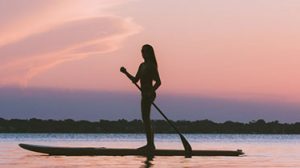By Terry Gibson
In a concerted effort to convince my girlfriend (now wife) Teresa to move here to Martin County, I took her on a series of “dates” that included the area’s most beautiful natural resources. So I started with an early morning snorkeling trip to Bathtub Beach, an utterly unique intersection of beautiful beach, nearshore reef, and the Indian River Lagoon estuary, located on the south end of Hutchinson Island. It’s a snorkeling experience we enjoy as much as work, family commitments and conditions allow. And it’s likely the place where our toddler, William, will get his first snorkeling lesson.
By early May this year, the sapphire waters spun in on eddies off the Gulf Stream current, as usual making for excellent snorkeling and diving conditions. Teresa and I waded off the beach into the translucent water, standing waste deep in water flat as a mirror while we donned our masks, fins and snorkels. You couldn’t ask for an easier to gear up for a beach dive.
We saw fish as soon as we put our faces in the water. Mojarra and croaker rooted out invisible worms and crustaceans from tiny ridges in the golden sand, while pilchards—a vitally important forage fish—streamed past in tightly packed schools. We quickly realized why the pilchards swam so close together and so quickly. The yellow-brown outlines of three big common snook moved tiger-like through the shallows. During the summer, Bathtub Beach is one of the best places to see this line-sided predator in action. It’s a species that’s only found in the open Atlantic along Florida’s beaches and reefs.
We kicked the 50 meters or so out to the first line of reef, which is a natural breakwater that creates a calm “lagoon” between the “bathtub” walls of beach and reef. The calm, safe conditions afforded by the “Bathtub” is the major reason why the beach is so popular among parents with young kids. It is a safe place for kids—or for anyone new to the ocean—to get comfortable in the water. I’ll warrant that more kids have seen their first live, wild fish underwater at Bathtub Beach than anywhere else along the Treasure Coast.
One of the shallow reef’s most obvious and fascinating features include the honeycomb-like mounds created by an extremely important and industrious marine worm called Phragmatopoma lapidosa. (There is a prize if you can pronounce that three times in rapid succession.) The worms gather sand grains stirred up by wave action, and build these impressive mounds by bonding sand grains together with their adhesive saliva. They rebuild the “worm reefs” every year, in the same places, thanks to a chemical mark left on the rock substrate.
Many species of fishes and invertebrates benefit from the worms. The worms themselves provide a source of food, and the structures add to the elevation and to the complexity of the reef, which provides hundreds of critters places to feed and hide. For those interested in adding fish species to your life list, several species of blenny and goby unique to the region, are found on and around the intertidal and submerged mounds.
Teresa and I quickly spotted a green sea turtle hanging out under a ledge, and several more juveniles surfacing and diving as they fed on algae growing on the reef. Martin County’s beaches are some of the world’s most important turtle nesting beaches, and most species of sea turtle are found sleeping and/or foraging on the adjacent reefs. Just with snorkel gear, you will almost certainly see green and loggerhead turtles. And if you can tell turtles apart, you may spot a hawksbill as well. Encounters with giant leatherback turtles are possible during nesting and hatching seasons.
Of the many larger invertebrates, we spotted a school of squid, an octopus, and two species of eel, including a young green moray. A couple of juvenile spiny lobsters also waved their antennae at us.
Moving down the reef, we saw a pair of hairy blennies guarding a nest, and spooked a school of striped croakers, a species that you’ll rarely find elsewhere than on the Treasure Coast’s nearshore reefs. Many species of parrotfish and angelfish across the full range of color/maturity stages grazed on the reef. Clouds of days-old grunts hovered in the water column. We counted several wrasse species, several damselfishes, as well as blue tangs and surgeonfishes. We were intrigued to by find four species of snapper huddled together as well, including gray, lane, schoolmaster and mahogany.
Leaving the water, we waved to the Martin County Lifeguards in their stands. They go on duty every day at 9am, ensuring a safe snorkeling experience during guarded beach hours. We rinsed off in the outdoor showers, and enjoyed a sandwich in the pavilion and counted our blessings in numbers of marine species that we live in Martin County.






